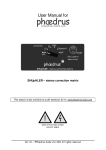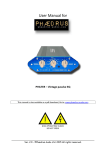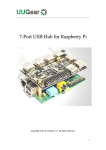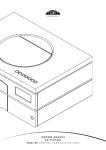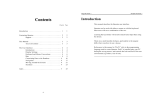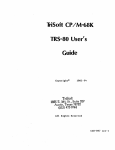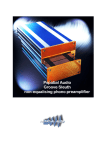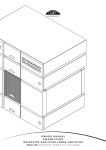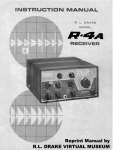Download here
Transcript
User Manual for PHAB - tube microphone preamp' PHAME - tube instrument preamp' & PHI - tube DI box This manual is also available as a pdf download, Go to: www.phaedrus-audio.com Ver. 1.1 - ©Phædrus Audio Ltd. 2011 All rights reserved. Preface – About Phædrus Audio Phædrus Audio was formed to design, manufacture and sell high-quali ty produc ts for the professional and semi-prof essional audio market. Phædrus Audio's founders remain inspired by the music and the recording prac tices of the fifties and six ties, and are motiva ted to re-establish the values of the grea t audio-tec hnology legends of the pa st with their ideals of transparency, handbuilt quality, and serviceability. Using modern manufac turing techniques and the benefi ts of mod ern component tec hnology, Phædrus Audio's ai m is to reproduce the quality and charac ter of classic equipment but in a modern, highly reliable, and cost-effec tive way. Chapter 1 - Background The Phædrus Audio PHAB, PHAME and PHI products ca me about because two, recording musicians wanted to own a "classic" console from the nineteen-six ties. Ideally a famous EMI, REDD, all valve (vacuum tube) mixer used to record The Bea tles. But those d esks make a collec tion of hen's teeth look posi tively prosaic as well as cheap! So, we set about researching with the idea of producing a replica console. In order to do thi s, first i t was necessa ry to have a design for the amplifier modules around which the mixers of this vintage are organised. In the fa mous EMI REDD mix ers, these a mplifiers were ei ther the German manufac tured V72(S) amplifiers or the, very ra re, EMI built, REDD.47 a mplifiers. Ver. 1.1 - ©Phædrus Audio Ltd. 2011 All rights reserved. V72 and REDD.47 modular amplifiers Ironically, despite the fac t tha t many more V72 a mplifiers exist than do REDD.47s, the EF804 valves which the German a mplifiers use are no longer in current produc tion and are becoming very expensive: wherea s the EF86 and ECC88 (E88CC) valves employed in the REDD a mplifiers remain in production and are widely available. So, a new amplifier, designed from the common source of Mullard's ref erence audio designs, and thereby sharing a common heri tage with the REDD amplifiers, was developed. We called this a mplifier the Phaedrus "PHILHARMONIC" (literally, music loving). Thi s PHILHARMONIC a mplifier forms the hea rt of the Phædrus Audio LONDON Mark II console. The PHILHARMONIC a mplifier circui t is described in detail below in section Circuit descriptions . Mullard published many reference designs which were used by EMI in developing the REDD amplifiers. Phædrus Audio went back to these same references to develop the PHAB, PHAME and PHI products. The prototype London Console (Mark II) Ver. 1.1 - ©Phædrus Audio Ltd. 2011 All rights reserved. PHAB The Phædrus Audio PHAB mic rophone prea mplifier is essentially the front-end of a single-c hannel of the LONDON console, in which PHILHARMONIC modular-a mplifier is combined with a rotary attenua tor, switc hable pad, high-pass filter and gain-swi tching circui try si milar to tha t employed in the fa mous six ties consoles. PHAB microphone preamp’ and PHAME instrument preamp’ PHAME The Phædrus Audio PHAME is a development of the PHAB in which the very high input i mpedance of the input pentode valve is exploi ted to provide a very high quali ty instrumental prea mplifier. PHI The Phædrus Audio PHI DI-Box is a produc t designed for a wide range of applications; from live use to the recording studio. Partnered with the PHAB i t provides a solution for almost any instrumental or vocal prea mp' applica tion. Construction - or star earths (grounds) and curly tracks PHI DI-Box Given their vintage, the V72 a mplifiers and the REDD.47 a mplifiers were buil t on a metal cha ssis, with the components hardwired onto tag-strips. Al though Phædrus Audio equipment uses printed circuit boards to ensure consi stent performance and reliability, the equipment follows "classic" prac tices suc h as star ea rths and "na tural contour" tracking, just like hook-up wire. Every Phæd rus Audio PHAB, PHAME and PHI produc t is hand assembled and individually tested. A test pro-forma is provided with every uni t. Phædrus Audio offer comprehensive service for products both inside and outside of their warranty period. Ver. 1.1 - ©Phædrus Audio Ltd. 2011 All rights reserved. Chapter 2 - Warranty and Service Please regi ster your purc hase wi th Phaedrus Audio at www.phaedrus-audio/registra tion.htm . This will simplify service & repair should you need this service. Your na me will be placed on our mailing list (unless otherwise requested) for future upda tes and new product announcements. Service If you experience a problem with a Phædrus Audio Ltd. produc t, contac t: [email protected] TELEPHONE: +44 207 193 4609 Skype ID: phaedrusaudio We will diagnose the problem remotely and advise you of the warranty sta tus. If a repair or replacement i s required, we will issue a Return Merc handise Authoriza tion (RMA) number and tell you where to send the uni t to be repaired . You MUST have an RMA number before you return the equipment to Phædrus Audio Ltd .'s support service. Be sure to write RMA number on outside of shipping box and to include your name, address, phone number, a copy of original sales invoice and a detailed desc ription of the problem. Phædrus Audio Ltd. will not accept responsibility for loss or damage in shipping or for equipment returned without valid paperwork and/or a valid RMA number. Remember, warranty is void if product serial numbers have been removed or al tered, or if the product has been da maged by abuse, accident or unauthorized modification and/or repair (see Phædrus Audio Ltd . Li mi ted Warranty for details). There are no user serviceable parts inside. PLEASE RETAIN Y OUR SALES RECEIPT. IT IS YOU R PROOF OF PURCHASE COVERING YOUR LIMITED WARRANTY. LIMITED WARRANTY IS VOID WITHOUT SUCH PROOF OF PURCHASE. Phædrus Audio Ltd.'s Limited Warranty This limited warranty is valid only if you purchased the product from Phædrus Audio Ltd. of from a Phædrus Audio authorized dealer in the country of purchase: a list of authorized dealers can be found on Phædrus Audio website www.phaedrus-audio.com, or by contacting [email protected]. Phædrus Audio Ltd. warrants tha t the equipment it manufactures shall be free from defects in material and workmanship for a period of one (1) year from the original date of purchase; unless a longer minimum warranty period is mandated by applicable local laws. If equipment fails due to such defects within this period, Phædrus Audio will, at its option, repair or provide a replacement for the defective part or product. Valves (vacuum tubes) are excluded from the one-year warranty, but are warranted for 90 days from day of purchase. This warranty does not extend to any Phædrus Audio Ltd. product that has been damaged or rendered defective as a result of: accident, misuse, or abuse; or by the use of parts not manufactured or supplied by Phædrus Audio Ltd.; or by unauthorized modification or attempted repair to the product; or by acts of God/Nature (accident, fire, flood, etc) or any other condition that is beyond the control of Phædrus Audio Ltd. There are no user serviceable parts inside. This limited warranty is invalid if the factory-applied serial number has been altered or removed from the product. This limited warranty is extended exclusively to the original buyer (customer of Phædrus Audio Ltd., or authorized retail dealer) and is not transferable to anyone who may subsequently purchase the product. No other person (retail dealer, etc.) shall be entitled to give any warranty promise on behalf of Phædrus Audio Ltd. Phædrus Audio Ltd. makes no other warranties, expressed or implied, of merchantability, fitness for a particular purpose or otherwise. Phædrus Audio Ltd. liability is limited to repair or replacement by Phædrus Audio Ltd., at its sole discretion and, in no event, will Phædrus Audio Ltd. be liable for any direct, indirect, special, incremental or consequential damages resulting from any defect in the product, including lost profits, damage to property and, to the extent permitted by law, damage for personal injury, even if Phædrus Audio Ltd. has been advised of the possibilities of such damages. Ver. 1.1 - ©Phædrus Audio Ltd. 2011 All rights reserved. Shipping Charges For any hardware defects experienced by the customer while the product is under warranty, Phædrus Audio Ltd. will incur the shipping cost to the customer and the customer is responsible for the shipping costs to Phædrus Audio Ltd's designated after-sales service office. For defective products that are out of warranty the customer is responsible for all shipping costs to and from Phædrus Audio Ltd’s designated after-sales service office. Extended warranty and out-of-warranty services Various services are available from Phæd rus Audio Ltd. These include repair services for equipment once the warranty period ha s expired, and the ability to ex tend the warranty period. These are: PHAB-REP - Repair of a defec tive PHAB prea mp', cha rged a t a flat-ra te PHAME-REP - Repair of a defec tive PHAME prea mp', charged a t a fla t-ra te PHI-REP - Repair of a defec tive PHI DI box, charged a t a flat-ra te PHAB-MISEAJ OUR - Mise à jour for PHAB prea mp'* PHAME-MISEAJOU R - Mise à jour for PHAME prea mp'* PHI-MISEAJ OUR - Mi se à jour for PHI DI box* PHAE-EXTWARR - Ex tends standard warranty (see above) by a further year** * A mise à jour service includes a complete inspec tion, re-valve (re-tube) and the i mplementa tion of any engineering updates a s well as a re-test to performance specification. ** If ex tended warranty is ordered af ter the ini tial warranty ha s expired then the intervening period is charged without exception. Please contac t your dealer or Phæd rus Audio Ltd. for current prices. Warranty service conditions are subject to change without notice. For the latest warranty terms and conditions and additional information regarding Phædrus Audio Ltd. limited warranty, please see complete details online at www.phaedrus-audio.com . Chapter 3 - Safety General Before using any piece of equipment manufac tured by Phædrus Audio Ltd., be sure carefully to read the applicable items of these opera ting instruc tions and the safety suggestions. Keep them for future referenc e. Follow the warnings indicated on the uni t, as well as in the opera ting instruc tions. Selection of PSU Suitable PSUs for the Phædrus Audio Ltd. PHAB and PHAME prea mplifiers and the PHI DI-Box are available as line items from Phæd rus Audio. They are: PHAE-PSU(110) - 110V mains plugtop PSU: plug is North American type. PHAE-PSU(220Euro) - 220V mains plugtop PSU; plug is European type PHAE-PSU(220UK) - 220V mains plugtop PSU; plug is 3 pin 13 AMP, British type Ver. 1.1 - ©Phædrus Audio Ltd. 2011 All rights reserved. A 12V AC supply is required for the Phædrus Audio PHAB, PHAME and PHI uni ts. A direc t current (DC) supply is NOT sui table and will damage the uni t. If a supply is sourced el sewhere than from Phædrus Audio, it must ha ve the following specifications: • • • • • 12V AC, 12 Wa tt supply or grea ter (> or = 1000mA supply current) Must be sui table for connec tion to the appropria te mains vol tage Must be Class-II, double-insula ted Must have 30% regula tion or better Must contain one-shot thermal fuses, resettable fuses, or Polyswitches for over-current protec tion. UK and Euro units should comply with EN 60950-1 and CE requirements and only PSUs with UL and CSA approvals should be provided on North American units. Uni ts supplied to other countries should be verified to comply with the relevant standards which obtain in those terri tories. User Access & Servicing Phædrus Audio equipment employs thermionic valve (vacuumtube) technology and employs haza rdous vol tages for the hightension supplies. THE USER SHOULD NOT ATTEMPT TO SERVICE THE UNIT. ALL SERVICING SHOULD BE REFERRED TO QU ALIFIED SERVICE PERSONNEL OR FACTORY ONLY. The PHAB and PHAME prea mplifiers and the PHI DI-Box should NEVER be connec ted to the ex ternal power supply or in any other way energised when the ca se is opened and/or the circui t board is accessible. PHI – Exposed valve (vacuum tube) safety The Phædrus Audio PHI DI-Box has an exposed 12AU7 (ECC82) valve (tube). In order to ensure safety, in all circumstances - even if the glass envelope of the valve (tube) were sma shed, the exposed vol tages ensure touch-current is li mi ted to a safe value. Nevertheless keep thi s produc t away from babies, c hildren and pets. DISCONNECT THE EXTERNAL PSU AND ALL OTHER CONNECTED EQUIPMENT WHEN REPLACING THE VALVE (TU BE). Ground (earth) issues Phædrus Audio Ltd .'s PHAB, PHAME and PHI produc ts a re all powered by external (12V AC) power supplies which should be double insulated, class-II types (see above). It should therefore be apprecia ted tha t, A CONNECTION TO EITHER THE PHAB, the PHAME of the PHI produc t CAN NEVER BE RELIED UPON PROVIDE A PROTECTIVE OR SAFETY EARTH (GROU ND). This advice obtains IRRESPECTIVE OF THE SETTINGS OF ANY "EARTH OR GROUND LIFT" SWITCHES. General Safety Instructions • • • Do not opera te Phædrus Audio equipment near any source of water or in excessi vely moist environments. Keep your Phædrus Audio equipment away from babies, c hildren and pets. Do not let objec ts do not fall, or liquids be spilled, into the enclosure. Ver. 1.1 - ©Phædrus Audio Ltd. 2011 All rights reserved. • • • • Situa te the Phædrus Audio equipment away from hea t sources or other equipment tha t produce hea t. Ensure Phæd rus Audio equipment has adequa te ventila tion. Improper ventila tion will cause overhea ting, and can damage the equipment. When cleaning Phædrus Audio equipment, remove all connections to the uni t; including power and gently wipe with a clean lint-free cloth; if necessary, gently moi stened with lukewarm or distilled water. Use a dry lint-free cloth to remove any remaining moisture. NEVER use aerosol sprays, solvents, or abrasives on Phædrus Audio equipment. Phædrus Audio equipment should be serviced by qualified service personnel or returned to Phædrus Audio Ltd . when: an objec t (or ob jec ts) ha ve fallen into the enclosure; or liquid has fallen into, or been spilled into the uni t; or the unit has been exposed to rain or high humidi ty; or the uni t does not opera te normally or exhibi ts a marked change in performance; or the uni t has been dropped, or the enclosure ha s been da maged. Chapter 4 - About Valves (Vacuum Tubes) Valve (tube) types The Phædrus Audio PHAB and PHAME prea mplifiers employ an EF86 pentode input valve (tube) and an ECC88, or E88CC, valve (tube) as the output device. Posi tions for the valves are very clearly marked on the PCB silkscreen as indicated in the illustra tion. The valves (tubes) tha t are installed in Phædrus Audio’s produc ts during assembly are selec ted to give the best possible performance. We offer versions of all products with NOS (ra ther than current produc tion) valves. But these must be c hosen carefully, and be pre-screened. Replacing the supplied valves (tubes) with different, collec tible, or “high-end” valves (tubes) types may not affec t any i mprovement and might cause deteriora tion of performance. EF86 The EF86 is a low noise pentode, originally manufac tured by many different fac tories and branded by Philips, Mullard, Telefunken, Valvo, and GEC, TESLA and Siemens/RFT. Many NOS valves are still available. Equivalents include the CV2901 (the UK service designa tion for the EF86) and the CV4085; a special quality version for mili tary use. The EF86 tube is still being produced in Russia and in the Slovak Republic under JJ Electronics brand na me (formerly Tesla). Chinese close equi valents are also still being manufactured. ECC88 The ECC88 is a fra me-grid, sharp cut-off, twin (dual) triode with an internal, separa ting screen. The valve was originally designed for service in the f ront ends of VHF radio receivers. The ECC88 (E88CC) tube type is equivalent to the North American 6DJ8 tubes and the (rare) milita ry branded CV2492. The transposi tion of the figures from ECC88 to E88CC was Mullard's way of denoting a special quality build and is equivalent to the US 6922. Russian 6N1P tubes and the Chinese 6N1 tube a re NOT equivalent. NEVER install a 6N1(P) in the Phædrus Audio PHAB or PHAME product. The ECC88 valve i s sill being manufac tured in China and in the Ver. 1.1 - ©Phædrus Audio Ltd. 2011 All rights reserved. Slovak Republic under JJ Elec tronics brand na me (formerly Tesla). 12AU7 or ECC82 The 12AU7 is a popular, minia ture 9-pin medium-gain dual triode valve (tube) and is used in many instrument and hi-fi a mplifiers. Both triodes are used, in cascade, in the Phædrus Audio PHI produc t. The 12AU7 is also known in Europe under i ts Mullard-Philips tube designa tion ECC82. This tube is widely available both new and NOS and a number of special quality equivalents a re available. Current production of 12AU7 takes place in Russia, Slovakia, and China. Phædrus Audio selec ts and recommend s the long anode (plate) version of the ECC82 (ECC802S) or 12AU7 valve for application in the PHI DI-Box. Valve (tube) lifetime You should replace the valves in the tubes in the Phædrus Audio produc ts only when you start to notice c hanges in the sound quality. If the gain of the prea mplifier decreases noticeably, then thi s is certainly evidence of the onset of valve (vacuum tube) failure. Before thi s, the tone may become "dull" and transients may be become "blunted". Tha t said, the lifeti me of a valve (tube) is largely determined by the lifeti me of i ts ca thode emission and the small-signal valves (tubes) used in the PHAB, PHAME and PHI use oxide cathodes, which can provide adequa te ca thode emi ssion for 100,000 hours or more. Tha t's over eleven year’s continuous use. So do not replace valves (tubes) just because they have seen a few years service. Phædrus Audio Ltd . can provide sui table valves (tubes) as spares which, af ter a burn-in period, are screened for best performance in your Phædrus Audio produc t. These a re available as line items: PHAE-12AU7 – Selected 12AU7/ECC82 type valve PHAE-ECC88 - Selected ECC88 type valve PHAE-EF86 - Selected EF86 type valve Please contac t your dealer or Phæd rus Audio Ltd. for current prices. Chapter 5 - Instructions for use Phædrus Audio’s PHAB, PHAME and PHI produc ts employ valves (vacuum tubes) as the ONLY ACTIVE DEVICES in the audio path. Valves (vacuum tubes) and their associated circuitry need ti me to reach an elec tronic equilibrium before they will operate a t opti mal specifications. Please therefore allow these produc ts to warm up for, a t least, 5 to 10 minutes before using them in your signal chain. To prolong the life of your valves (tubes), i t is recommended tha t you turn off these units when not in use. Ver. 1.1 - ©Phædrus Audio Ltd. 2011 All rights reserved. Typical connection set-up for the PHAB PHAB Application and connections Mixer and computer interface manufacturers opera te in a very competi tive environment. Even a small mixer must (by definition) contain 8, 16 or perhaps 32 microphone a mplifiers. Si milarly, a computer interface designer has to "shoe-horn" a microphone a mplifier into a box with a host of other fea tures and a noisy, semi -digital environment. Unsurpri singly, these a mplifiers are designed on a careful budget and contain some compromi ses. Henc e, the use of a few dedicated, stand -alone microphone prea mplifiers, solely designed with sound -quality in mind, can transform the quality of your recorded signals. Tha t is the ai m of the Phædrus Audio PHAB tube microphone prea mplifier: to offer just suc h a no compromi se microphone a mplifier in a produc t which incorpora tes the standards and qualities adopted in classic recording gea r. A block diagram of the PHAB is given below. The unit i s connec ted as shown in the accompanying diagrams. Archi tecture of the PHAB preamp' Controls Input rotary attenuator, Pad and Gain switch The PHAB microphone prea mplifier opera tes wi th a constant-gain a mplifier and a ttenua tes the signal reaching the a mplifier for level control. This is NOT common with modern equipment; in which the gain is adjusted by modifications to the feedback network. Yet this approach was completely standard in the 1950s and 1960s. Ver. 1.1 - ©Phædrus Audio Ltd. 2011 All rights reserved. The Phædrus Audio PHAB tube prea mplifier is built around a modular a mplifier with a fixed gain of +40dB (with a switc h available to raise this to approxi ma tely +46dB). This a mplifier is preceded by a rotary, switc hed a ttenua tor control, offering a ttenua tion of 0 to -30d B in steps of 6dB. A further pad (opera ted by a front panel switc h) is available, to increa se the a ttenua tion to -40dB; thereby ma tc hing the gain of the modular a mplifier and reducing the overall unit gain of the equipment to uni ty. These controls (the input a ttenua tor, pad and the gain switc h) are used to set the overall prea mplification level of the uni t and feed a sui table elec trical level to your downstrea m equipment. (see Operating level sec tion for more informa tion). Normal opera tion should be to opera te WITHOUT the -10dB pad engaged and with the prea mplifier gain set to 40dB. Only opera te the pad switch when the signal from the mic rophone is too grea t for a ttenua tion via the rotary a ttenua tor control: and only opera te the +46dB gain switch when the signal from the mic rophone is too low, even when the rotary a ttenua tor is set to 0dB. HPF (rumble filter) By virtue of its very high quali ty input and output transformers and i ts mini malist, wideband, valve circuitry, the pa ss-band of the Phædrus Audio PHAB prea mplifier is ex tended in both the bass and extra-high f requency ranges. Due to thi s, unwanted, very low frequencies, due to traffic or airconditioning "rumble" may be picked up by the microphones and a mplified. The high-pass filter (HPF) filters out these frequencies and prevents them from ei ther, intermodulating with the wanted signals with in the microphone prea mp' i tself, or, being fed to downstrea m equipment. This filter sec tion is engaged by depressing the HPF switc h. +48V "Phantom" supply An internal phantom supply is provided to power the microphone connec ted to the input. This supply is engaged by depressing the "+48V" switc h on the front panel of the uni t. Al though this supply is designed to "ra mp-up" slowly, it is NEVER a good idea to swi tch phantom power onto a microphone on a channel with an open fader because i t can crea te "pops and bangs" which can damage elec tronic equipment, speakers and fray nerves! Always mute any following circuit before switching on the phantom (+48V) supply. To a void loud transients, always make sure phantom power is off when connecting or disconnec ting microphones.This supply is designed to support the hungriest of microphones. NOTE: Some microphones may be damaged by having phantom-power applied to them: ribbon microphones are especially delicate in this regard. ALWAYS check what type of microphone is connected, and that it is suitable for phantom-powering BEFORE operating the front-panel switch. Ver. 1.1 - ©Phædrus Audio Ltd. 2011 All rights reserved. PHAME Application and connections Archi tecture of the PHAME preamp' The uni t is connec ted as shown in the accompanying diagra ms. Direc t injec tion (DI) provides a clean way of applying instruments to your mixer or computer interface. This is especially interesting today, now tha t there a re so many plug-in effec ts and amplifier emulations which run as sof tware on the computer host. All tha t is required, when working this way, is to get a na tural signal into the computer's analogue to digi tal conversion circuits. The sof tware will then " take i t from there". How to connect the PHAME preamp' But if only things were tha t si mple! The problem is tha t a normal passive DI-box, or a solid-sta te input stage can rarely offer the benefi ts of a valve prea mplifier. (See Voicing and the valve (tube) amplifier box.) Ver. 1.1 - ©Phædrus Audio Ltd. 2011 All rights reserved. Voicing and the valve (tube) amplifier Guitar pickups are made by winding about 8000 turns of wire on a former or bobbin which surrounds several permanent magnets. The resistance of the wire is relatively low, but the inductance is high and the device therefore has a rising output impedance. The guitar connects to the amplifier by means of a coaxial cable with the inner, signal wire surrounded by the earthy "screen". The construction of this type of cable is not a million miles away from the construction of a capacitor and, unsurprisingly, the coaxial cable displays a significant capacitance at audio frequencies. When the inductive pickup is connected via a capacitive cable, a resonant circuit is formed and we can model this and confirm tha t this creates a musically-significant resonant-circuit well within the audio band. (Left trace below.) This resonant mechanism is one of the principal voicings for the electric guitarist. Three factors affect the resonant circuit: the inductance of the pickup; the capacitance of the cable; and the input impedance of the amplifier: essentially the greater the capacitance and the greater the inductance, the lower the formant frequency. This is why expensive "Custom Wound" pickups and Humbuckers (which have more turns and therefore greater inductance) sound considerably more "chunky" or "fatter" than standard pick-ups. It's the major reason why cables really do sound different; fatter cables (because of their lower capacitance) "singing" better than cheap, thin cables. The effect of the amplifier input resistance is to damp the resonant circuit. Valve preamplifiers do not do this because of the common value of 1MΩ for the bias resistor of the first valve. Solid state circuits on the other hand – due to their higher bias currents and lower circuit impedances – can have a major damping effect on the input signal, destroying so much of the character imparted by the resonant circuit (see right-hand trace above). In short, the formant frequency is absolutely crushed and the character of the voice destroyed. Amongst many other reasons, this, so many solid-state guitar preamplifier designs fail to have the "spring" and "life" of a good valve amplifier: the precious signal is choked before it reaches (literally and metaphorically) first base! Controls Input attenuator The input a ttenua tor i s a good quality, high-value potentiometer; just like the volume control on an amp’. Set this control so as to d rive the appropria te level to the downstrea m equipment; see Operating Levels sec tion. Gain select (low/ high) The gain selec t switc h should normally be set to the low posi tion. In the high posi tion i t is possible to overdrive the tube prea mplifier circui try from a gui ta r. This setting is for low output instruments and/ or crea tive effec ts only. Ver. 1.1 - ©Phædrus Audio Ltd. 2011 All rights reserved. Ground (earth) lift Hums and buzzes are the bane of an audio engineer’s life. Unfortuna tely, it is the na ture of a highimpedance, unbalanced instruments like an elec tric gui tar to be highly susceptible to the AC electromagnetic fields thrown off by all mains-powered equipment. Of ten all tha t is required to solve the problem and reduce the hum (and/or buzz) to a manageable level is to orient the instrument differently so tha t the pickups no longer intercept so much c hanging flux. But someti mes hums and buzzes prove to be pa rticularly stubborn and intrac table, regardless of the guitari st’s pirouetting! When this happens, i t is usually because of a ground-loop (or earth-loop). A ground -loop forms when an unbalanced, audio signal flows in a circuit in which the signal-return (usually the cable braid), provides a current pa th which is in parallel with the installation earth. This is a problem because "all earths are not equal". Tha t's to say, the installation ea rth will be carrying certain leakage currents. These currents set up a potential across the installa tion wiring which drives a circula ting current in the braid of the audio cable. The resul t is a “hum” vol tage superi mposed upon the audio signal. The adoption of balanced signals, and especially audio transformers should ensure tha t groundloops (or earth-loops) should NEVER occur. Certainly the Phæd rus Audio PHAME, by being both double-insulated and incorpora ting an ea rth-free, transformer-balanced output stage can never crea te a ground -loop in a correc tly wired studio. However, connec tion to an earthed (or grounded) guitar a mplifier can cause a circulating current should pin 1 of the output XLR be earthed (grounded) elsewhere in the installa tion. This is the role of the GROUND-LIFT switc h. It interrupts the connec tion of pin 1 of the output XLR to the c hassi s of the PHAME and to the sleeve and screen of the guita r wiring. Adjust the posi tion of this switc h to eli mina te any ground -loop “hums”. Please note, as explained in the Chapter 4, tha t, because the Phædrus Audio produc ts are double-insula ted, they CAN NEVER BE RELIED UPON PROVIDE A PROTECTIVE OR SAFETY EARTH (GROUND). This advice obtains IRRESPECTIVE OF THE SETTINGS OF ANY "EARTH OR GROU ND LIFT" SWITCHES. Buzz? The PHAME preamplifier, like a lot of modern audio gear, is designed to operate from a double-insulated power supply. If the rest of the equipment in your recording set-up is double-insulated too (for instance, you might be using the PHAME with a laptop computer), it is possible for your entire audio installation to operate without a mains earth. This represents no problems from a safety point of view. However it can cause the unbalanced, high-impedance input of the PHAME to be very susceptible to electrosta tically induced mains-interference. The tell-tale signs here are a high level audio “buzz” rather than a “hum” on the outpu t signal, and the phenomenon that the instrument (particularly electric- and bass-guitar) is very “live” so that simply touching the strings may worsen or improve the buzz. In this situation, it is recommended tha t pin 1 of the output connector of the PHAME be connected to mains-earth (ground) or a technical-earth, and the “LIFT” switch be left in the out position. Ver. 1.1 - ©Phædrus Audio Ltd. 2011 All rights reserved. Operating levels Because of the vintage of the PHAB and PHAME prea mplifier designs and their origin in German manufac tured broadcast television and radio equipment, the envisaged opera ting level for this equipment is slightly lower than mod ern recording industry standards. When feeding downstrea m equipment, the output level should be set to a nominal 0dBu (0.775V RMS). This means tha t if moni toring the output on a standard VU instrument, the input a ttenua tor should be set so tha t the output level reads around -4VU, with occasional peaks to 0VU on progra mme. On a digital meter, thi s is equivalent to signal peaks reading +6dB above recording industry standard +4dBu alignment level. Thi s is equivalent to +10dBu (or -8d BFS on equipment aligned to EBU EBU R64-1992 standard and -14d BFS on equipment aligned to SMPTE RP155 as illustra ted). On a broadcast standard PPM, peaks should be set to read 6 on the BBC scale, or +8 on the European EBU scale. Output level is sufficient easily to modula te semi -pro' equipment (mixers, DAT, solidsta te recorders and many sound card s) to 0dBFS. Tha t said, the headroom on the PHAB and PHAME is considerable, and no noticeable distortion is evident when opera ting the equipment a t standard recording industry levels of +4dBu=0VU, or even higher. There is thus considerable scope for experi menta tion with over driving this vintage circui try to explore i ts c harac ter in gradual overload. For exa mple, peaks may be allowed to reach +18dB above alignment level without clipping. The Phædrus Audio PHAB and the PHAME prea mplifiers may thus be used direc tly to feed mod ern A to D conversion equipment aligned to EBU or SMPTE standards following the recommenda tions illustra ted (right). Ver. 1.1 - ©Phædrus Audio Ltd. 2011 All rights reserved. PHI Application and connections Simple DI uni ts utilise a transformer to balance the unbalanced signal and feed it to the microphone input of your mixer or microphone prea mplifier. This technique provides a reasonably highimpedance as presented to the instrument; typically a few tens of thousand s of ohms. Adequa te for a keyboard, for exa mple: a t a push, sufficient for a bass gui tar. But the tone of an electric gui tar is completely destroyed, unless i t drives an i mpedance hundreds of ti mes grea ter than can ever be provided by a transformer. The only answer is to present the instrument with the very high input i mpedance, suc h as i t "sees" when plugged into a valve a mp' (see Voicing and the valve amplifier sec tion above). This is the role of the Phædrus Audio PHI DI-Box. The dual valve (tube) stage ac ts a s an i mpedance-converter, presenting the instrument input with an impedance of approxi ma tely 1MΩ. The output of the uni t then f eeds the microphone input of your mixer, computer interface, or your PHAB prea mplifier. The Phædrus Audio PHI DI-Box is connec ted as shown in the diagra ms above. Ensure tha t the "LOUDSPEAKER/INSTRUMENT" swi tch is in the "INSTRUMENT" posi tion. However, note tha t feeding the output of the PHI into the studio console will negate some of the benefi ts of the PHI’s unique charac ter. Use a premium-quali ty microphone prea mplifier (suc h as Phædrus Audio’s PHAB) for the very best resul ts a s shown below. Ver. 1.1 - ©Phædrus Audio Ltd. 2011 All rights reserved. Controls Instrument/ Loudspeaker switch – LOUDSPEAKER MODE As a general rule, gui tar and bass gui tar and certain elec tric pianos and organs rely on the distortions in their a mplifiers and loudspeaker-cabinets for the c harac ter of their sound. Ideally of course, these instruments need to be captured with mic rophones, ra ther than applying a linelevel signal to the mixer. However, thi s is not always possible for a host of reasons including: unacceptable "spill" from other sources; feedback problems; room resonance issues; cabinet "buzz", inadequate microphone response and so on. In this si tua tion, it i s useful to be able to DI, not the output from the instrument, but the signal which drives the loudspeaker. This signal is not modified by the cabinet, but i t does have - a t lea st - the cha rac ter of the a mplifier, its tonal modifications and distortion c harac teristics, i mprinted upon it. The Phæd rus Audio PHI is able to provide this func tionality. However, this loudspea ker signal is of a very muc h larger a mplitude than this signal which leaves the instrument - i t ha s been amplified after all! It is therefore necessary to a ttenua te thi s signal before presenting to the DI circuitry and this is exac tly wha t is done when the "LOUDSPEAKER/INSTRUMENT" swi tch is moved to the "LOU DSPEAKER" posi tion. The a ttenua tion is -32dB. YOU MUST SELECT THE “LOU DSPEAKER” POSITION OF THE LOUDSPEAKER/INSTRU MENT SWITCH WHEN CONNECTING THE Phædrus Audio PHI TO THE LOU DSPEAKER CIRCUIT OF Ver. 1.1 - ©Phædrus Audio Ltd. 2011 All rights reserved. AN AMPLIFIER. NOT SO DOING WILL DAMAGE YOUR Phædrus Audio PHI. FU RTHERMORE YOU MUST OBSERVE THE WARNING GIVEN BELOW, AS FAILURE TO DO THIS COULD DAMAMGE YOUR AMPLIFIER. When the Phædrus Audio PHI is used in LOUDSPEAKER mode, it is important to observe the correct polarity of the signal fed from the amplifier to the PHI. To avoid short-circuiting the output of the amplifier, the earthy side of the loudspeaker signal MUST be connected to the sleeve of the input jack. In addition, as a precaution, ALWAYS operate with the Ground lift switch in the “LIFT” position when operating the PHI in this way. Furthermore, the Phædrus Audio PHI is NOT a dummy load and a loudspeaker MUST be attached to the THRU output so as to provide the correct load for the power amplifier. Valve amplifiers especially may be damaged without the correct speaker-load connected. Flat/ Cabinet switch The problem with the signal from the a mplifier is tha t i t of ten contains many high frequencies which are not reproduced by instrumental loudspeaker cabinet. The resul t is a “fizzy”, over-bright signal; very different from tha t heard from the loudspeaker. The rea son for this is tha t the loudspeaker and cabinet ac t together to form an asymmetrical band-pass fil ter; steeply attenua ting the treble above about 4kHz, and gently rolling off the bass. The signal from the a mplifier may therefore be very grea tly i mproved by the incorpora tion of an electrical filter which reproduces the elec tro acoustic band-pa ss of the loudspeaker cabinet. To this end, the Phædrus Audio PHI - DI uni t, is enhanced by the inclusion within the uni t of a loudspeaker-emula tion filter which i mprints the response of a typical, closed-back, guitar cab' onto the signal. The general response of this fil ter is illustra ted above. Essentially the response falls away gently in the ba ss, peaks in the mid-treble and falls away rapidly above about 4kHz as shown in the figure. Ground (earth) lift A ground -loop (earth-loop) forms when an unbalanced, audio signal flows in a circuit in which the signal-return (usually the cable braid), provides a current pa th in parallel with the installation earth (ground). Small potentials in the installation earth (ground) wiring, drive a circulating current in the braid of the audio cable. The resul t is a “hum” vol tage superi mposed upon the audio signal. Ver. 1.1 - ©Phædrus Audio Ltd. 2011 All rights reserved. The adoption of balanced signals, and especially audio transformers should ensure tha t groundloops (or earth-loops) should NEVER occur. Certainly the Phæd rus Audio PHI, by being both double-insulated and incorpora ting an ea rth-free, transformer-balanced output stage can never crea te a ground -loop in a correc tly wired studio. However, connec tion to an earthed (or grounded) guitar a mplifier can cause a circulating current should pin 1 of the output XLR be earthed (grounded) elsewhere in the installa tion. This is the role of the GROUND-LIFT switc h. It interrupts the connec tion of pin 1 of the output XLR to the c hassi s of the PHI and to the sleeve and screen of the gui tar wiring. Adjust the posi tion of this switc h to eli mina te any ground -loop “hums”. Please note, as explained in the Chapter 3, tha t, because the Phædrus Audio produc ts are double-insula ted, they CAN NEVER BE RELIED UPON PROVIDE A PROTECTIVE OR SAFETY EARTH (GROUND). This advice obtains IRRESPECTIVE OF THE SETTINGS OF ANY "EARTH OR GROU ND LIFT" SWITCHES. Buzz? The PHI DI-Box, like a lot of modern audio gear, is designed to operate from a double-insulated power supply. If the rest of the equipment in your recording set-up is double-insulated too (for instance, you might be using the PHI with a laptop computer and USB interface), it is possible for your entire audio installation to operate without a mains earth. This represents no problems from a safety point of view. However it can cause the unbalanced, high-impedance input of the PHI to be very susceptible to electrosta tically induced mains-interference. The tell-tale signs here are a high level audio “buzz” rather than a “hum” on the outpu t signal, and the phenomenon that the instrument (particularly electric- and bass-guitar) is very “live” so that simply touching the strings may worsen or improve the buzz. In this situation, it is recommended tha t pin 1 of the output connector of the PHI be connected to mains-earth (ground) or a technical-earth, and the “LIFT” switch be left in the down position. Chapter 6 - Circuit descriptions PHAB & PHAME The Phædrus Audio PHAB and the PHAME prea mplifiers share roughly the sa me prea mplifier circuit which is illustra ted in general form below. The differences mainly lie in the input circui try and attenua tor controls. Both devices opera te wi th a constant-gain a mplifier and a ttenua te the signal reaching the a mplifier for level control. In the case of the PHAB, the valve prea mplifier has a fixed gain of +40dB (with a switch a vailable to raise this to approxi ma tely +46d B). The a mplifier is preceded by a switc hed a ttenua tor control offering a ttenua tion of 0 to -30dB in steps of 6dB. A further pad (opera ted by a front panel switc h) is available, to increa se the a ttenua tion to -40dB; thereby ma tc hing the gain of the a mplifier and reducing the overall unit gain to uni ty. In the case of the Phædrus Audio PHAME, the prea mplifier does not incorpora te an input, balance-to-unbalance transformer. Instead the instrument feeds to grid of the EF86 pentode via a continuous a ttenua tor (pot') to ensure a very high input i mpedance. This i s vi tal to ensure the best tone from all elec tric instruments, and especially elec tric and bass gui tars. The fixed gain of the amplifier is +24dB (>30d B with the high-gain switch depressed). Ver. 1.1 - ©Phædrus Audio Ltd. 2011 All rights reserved. The a mplifier block is a two-stage design incorpora ting an EF86 low-noise pentode in the first stage and a paralleled ECC88 high mutual-conduc tance double-triode as the output stage. All the landmark a mplifier designs from Mullard's applica tion laboratories specified the EF86. In fac t, Mullard described the EF86 as a low noise pentode intended for use as a RC coupled AF vol tage amplifiers; particularly in the early stages of high gain audio amplifiers, microphone preamplifiers and magnetic tape recorders. The output stage compri ses a dual triode valve in which the two devices a re wired in parallel. This paralleling of the two triodes has the beneficial effects of doubling the mutual conductance and halving the anode resistance. The la tter charac teristic is pa rticularly valuable in ensuring a low impedance drive to the output transformer. The output stage direc tly feeds the output step-down transformer. The output is balanced and earth free. A modest degree of nega tive feedback is taken from the anode of the output valve(s) to the ca thode circui t of the input stage to stabilise gain, ex tend frequency-response and lower distortion. A change to this feedback network i s employed to effec t the gain switc hing (from 40dB to 46dB in the PHAB and from 24dB to >30dB in the PHAME), less feedback being applied to achieve higher gain. In the case of the Phædrus Audio PHAB mic rophone prea mplifier, the grid of the input pentode i s driven from the input transformer. In the case of the PHAME, this transformer is not fi tted . Performance At recording industry line-up (0VV=+4d Bu) the magni tude of all distortion components on a 1kHz sine wave input a re less then -55dB below fundamental. This, and the A-weighted noise response relati ve to maxi mum output, is illustra ted below. Ver. 1.1 - ©Phædrus Audio Ltd. 2011 All rights reserved. High Pass or Rumble filter (HPF) The input stage in the PHAB i s fed by a 1:7 transformer. When a capaci tor is included in series with the transformer pri mary (i t is usually shortcircuited out of circui t), the capacitor forms a half-sec tion fil ter with the pri mary induc tance of the transformer pri mary; resulting in a sharp cutoff, high-pass filter. The response of the PHAB with and without the rumble fil ter is illustra ted (right). PHI circuit description The system diagra m for the Phæd rus Audio PHI-DI Box is shown. In effec t, before the signal from the instrument is applied to the transformer, i t is buffered by a dual cathode-follower circuit. The first sta ge runs a t very low current and is biased by a sepa ra tely derived bias supply. This ensures a high and consistent input i mpedance. The second stage is DC-coupled to the first and runs in a higher quiescent current; consistent with having sufficient drive to overcome the excita tion current in the transformer a t low frequencies. Loudspeaker input In this configura tion, i t is necessa ry to a ttenua te the loudspeaker d rive signal before presenting to the DI circui try and this i s exac tly what i s done when the "LOUDSPEAKER/INSTRUMENT" switch is moved to the "LOUDSPEAKER" posi tion. The a ttenua tion is -32dB. In the Phædrus Audio PHI - DI uni t, this fea ture is enhanced by the inclusion within the uni t of a loudspeaker-emula tion filter. The general response of this fil ter was illustra ted above. The LF roll-off is accomplished with a single-pole, RC response. The upper skirt of the pa ssband is i mplemented by means of a single-termina ted LC filter. Ver. 1.1 - ©Phædrus Audio Ltd. 2011 All rights reserved. Specifications Electrical connections Input: Unbalanced: 3 pin XLR Connector Pin 1 – Ground Pin 2 – (+) Signal Pin 3 – Connect to Pin 1 Balanced: 3 pin XLR Connector Pin 1 – Ground Pin 2 – (+) Signal Pin 3 – (-) Signal Output: Unbalanced: 3 pin XLR Connector Pin 1 – Ground Pin 2 – (+) Signal Pin 3 – Connect to Pin 1 Balanced: 3 pin XLR Connector Pin 1 – Ground Pin 2 – (+) Signal Pin 3 – (-) Signal PHAB Specification Circuit configuration: 3 valve (vacuum tube) design Output: Balanced, transformer coupled Maximum output level: +18dBu @ 1kHz Input: Balanced, transformer coupled Maximum input level: +8dBu (without PAD), +18dBu (with PAD) at 1kHz Gain: +40dB (± 1dB) - normal setting, approximately +46dB - high setting Attenuation: -30dB to 0dB in steps of 6dB; minus a further 10dB, by engaging PAD Frequency response: 40Hz to 15kHz, ±1dB: 15Hz to 30kHz ±3dB Distortion: <0.2%, 1kHz @ -4VU (0dBu), gain 40dB : <1%, 40Hz @ -4VU (0dBu), gain 40dB Noise: <-120dB referred to input Power supply: 12V AC Power consumption: 8 Watts Phantom Supply: +48V DC, up to 5mA PHAME Specification Circuit configuration: 3 valve (vacuum tube) design Output: Balanced, transformer coupled Maximum output level: +18dBu @ 1kHz Input: Unbalanced, high-impedance Maximum input level: Effectively infinite. Signals >2V RMS not recommended. Gain: 24dB – low-gain setting, >30dB – high-gain setting Attenuation: Continuous. Max > -60dB Frequency response: 40Hz to 15kHz, ±1dB: 15Hz to 30kHz ±3dB Distortion: <0.2%, 1kHz @ -4VU (0dBu), gain 40dB: <1%, 40Hz @ -4VU (0dBu), gain 40dB Noise: <-120dB referred to input Power supply: 12V AC Power consumption: 8 Watts PHI Specification Circuit configuration: 2 valve (vacuum tube) design Output: Balanced, transformer coupled Maximum output level: XX, just prior to waveform clipping @ 1kHz Input: Unbalanced, high-impedance Maximum input level (INSTRUMENT): 2V RMS Maximum input level (LOUDSPEAKER): 100V RMS Gain: -18dB Power supply: 12V AC Power consumption: 2 Watts Phaedrus Audio Ltd. reserves the right to alter these specifications without notice. Ver. 1.1 - ©Phædrus Audio Ltd. 2011 All rights reserved. Declaration of Conformity The Manufacturer of the Products covered by this Declaration is Phædrus Audio Ltd. head office address The directives covered by this declaration are: 89/336/EEC El ectromagnetic Compatibility directi ve 73/23/EEC Low Voltage Equipment directive The products covered by this declaration are: Phædrus Audio PHAB – microphone preamplifier; Phædrus Audio PHAME – instrument preamplifier; Phædrus Audio PHI – DI-Box. The basis on which conformity is being declared: The manufac turer hereby declares tha t the produc ts identified above comply with the protec tion requirements of the EMC direc tive and with the principal elements of the safety ob jec tives of the Low Voltage Equipment direc tive, and tha t the following standards have been applied: IEC INTERNATIONAL STANDA RD 60065 - Audio, video and similar electronic apparatus – Safety requirements The technical documenta tion required to demonstra te tha t the produc ts meet the requirements of the Low Voltage Equipment direc tive ha s been compiled and is available for inspec tion by the relevant enforcement authori ties. The CE ma rk was first applied in 2011. Signed: Date: Richard Brice, Technical Director January 2011 Ver. 1.1 - ©Phædrus Audio Ltd. 2011 All rights reserved. Appendix - TEST PRO-FORMA Product: PHAB / PHAME Serial Number: ________________ Tested by: ________________ V1 vol ts: ___________ Vol ts TP1: ___________ Vol ts TP2: ___________ Gain set: ______dB (40dB or LOW GAIN posi tion) High ain test Pass / Fail Distortion test: Pass / Fail PAD test: Pass / Fail Frequency response test: HF (-3dB) ex tension: Pass / Fail Frequency response test: LF (-3dB) ex tension: Pass / Fail Phantom (+48) supply test: Pass / Fail / N/A Listening test: Pass / Fail Product: PHI Serial Number: ________________ Tested by: ________________ Gain test Pass / Fail Distortion test: Pass / Fail Frequency response test: HF (-3dB) ex tension: Pass / Fail Frequency response test: LF (-3dB) ex tension: Pass / Fail Listening test: Pass / Fail Ver. 1.1 - ©Phædrus Audio Ltd. 2011 All rights reserved.
























